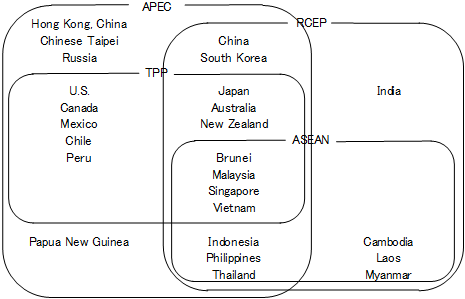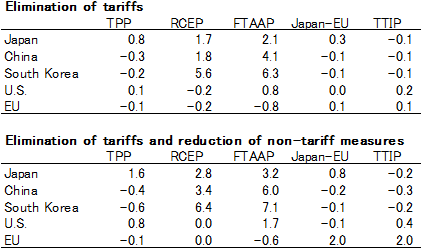The move to economic partnerships accelerated worldwide in 2013, including the beginning of three-way negotiations among the large economies of Japan, the United States, and the European Union (EU). In the Asia-Pacific region, Japan is taking part in negotiations over the Trans-Pacific Partnership (TPP), while negotiations have begun on the Regional Comprehensive Economic Partnership (RCEP) for East Asia. Negotiations also began in the same year for an economic partnership between Japan and the EU and for the Transatlantic Trade and Investment Partnership (TTIP) between the United States and the EU.

This column quantitatively discusses the macroeconomic effects of economic partnership agreements (EPAs) on the overall economy. In so doing, it uses simulation analysis with an economic model to compare the relative importance of the different economic partnerships. (For details about the effectiveness analyses of the TPP, the RCEP, and the Free Trade Area of the Asia-Pacific (FTAAP), refer to "The Relative Significance of EPAs in Asia-Pacific," 14-E-009, RIETI Discussion Paper Series, January 2014.)
Estimated macroeconomic effects that mega EPAs, such as those covering the Asia-Pacific region, between Japan and the EU, or the TTIP, would have on Japan, China, South Korea, the United States, and the EU are as shown in the Figure 2. Here, macroeconomic effects are evaluated as the ratio of the equivalent variation to the gross domestic product (GDP) in percentage terms. Equivalent variation is an indicator of changes in macroeconomic income and expenditures. It also takes into account the terms-of-trade effects resulting from changes in export and import prices, something that is not fully captured by the real GDP. Thus, it may be considered as a more suitable indicator of economic welfare.

TPP and RCEP are mutually complementary
For Japan, the economic effects of tariff elimination and non-tariff measure reduction are estimated at 3.2% with the FTAAP, which is greater than either that of the TPP (1.6%) or the RCEP (2.8%). Rather than choosing between the TPP and the RCEP, it has been suggested that it is important for Japan to pursue both in order to enjoy greater economic effects than that under the FTAAP. Under the TPP, Japan would achieve a higher level of economic partnership, while the RCEP would be the key to turning East Asia, where growth is quite substantial, into a market for Japan. On the one hand, the TPP, in which the United States will participate, and the RCEP, in which China will participate, would be competing against each other in terms of Asia-Pacific politics and diplomacy. As far as economic effects are concerned, however, they would be mutually complementary relationships.
Determining which would have greater economic effects, the TPP or the RCEP, requires being mindful of the unpredictable aspects of the question. This analysis includes a strictly mechanical trial calculation, assuming 100% elimination of tariffs and 50% reduction of non-tariff measures. Very likely, in any actual agreement, some items will continue to have tariffs. It also has been pointed out that in economic partnerships conducted to date, tariff reductions have been greater in free trade agreements (FTAs) in which the United States participates than in economic partnerships in East Asia. Actual economic effects would have to be verified based on specific agreement details.
Reducing non-tariff measures is even more important
Elimination of tariffs under the TPP would have an estimated economic effect of 0.1% for the United States. In comparison, if non-tariff measures were also reduced, the combined effect would be much larger: 0.8%. The TPP is a very ambitious attempt to build new, wide-ranging economic integration rules for the 21st century. It would cover not just goods but also services, investments, and more. Reducing non-tariff measures is likely to provide larger economic effects.
The economic effects of tariff elimination to the United States would be an estimated $11 billion. The major contribution, $6 billion, would come from the elimination of Japanese tariffs. That would outstrip the $1 billion effect of eliminating the Unite States' own tariffs. The United States already has FTAs with TPP members and potential members such as Canada, Mexico, and Australia. It is self-evident that Japan, one of the major countries which are still not part of such an FTA, would make a comparatively large contribution.
But even more interesting is the effect of reducing non-tariff measures. It is estimated that such reductions would give the United States an economic effect of $102 billion. Of this, the contribution from the United States itself ($40 billion) would far exceed that from Japan ($6 billion). This suggests that the United States can enjoy a greater economic effect from reducing its own non-tariff measures than from getting Japan to eliminate its tariffs. It is fair to say that the key to getting greater macroeconomic benefits from economic partnerships is to reform one's own market.
Serious impacts on third party countries
Tariff elimination under the FTAAP would have a negative effect (-0.8%) on the EU. This is larger in scale than the economic effect of either the Japan-EU Economic Partnership Agreement (0.1%) or the TTIP (0.1%). Trade liberalization expands trade for the nations that are directly participating, but it is also known to divert trade away from the business between participants and third party countries. There is fear that stronger relationships within the Asia-Pacific region could endanger the EU's export market.
The estimated negative effect of the FTAAP (-0.6%) to the EU when the reduction of non-tariff measures is also included is not insignificant. Nonetheless, it is estimated that the economic effects of the Japan-EU Economic Partnership Agreement (2.0%) and the TTIP (2.0%) would be greater. It has been suggested that reducing its own non-tariff measures is important for the EU as well.
Moreover, reducing non-tariff measures, unlike eliminating tariffs, is believed to have a ripple effect to some extent that reaches even third party countries. However, this "free-rider" effect is not necessarily great. It is vital that countries actually join economic partnership frameworks.
The economic effects of economic partnerships persist over the medium- to long-term through gains in productivity and the like, and serves as the engine that increases a nation's growth potential. To enjoy greater economic benefits, more nations should become involved in partnerships covering a wider range of transactions. Asking which economic partnership framework is the most effective is a moot question. The analysis described in this column, in particular, suggests that the economic effect from reducing non-tariff measures, in addition to tariff elimination, is important. Even when nations pursue international policies such as economic partnerships, the key is successful economic structural reform in their domestic markets.


